|
FAQs about Marine Worms, Vermiform Animals
Identification 16
Related FAQs: Worm
IDs 1, Worm IDs 2, Worm IDs 3, Worm
IDs 4, Worm IDs 5, Worm IDs 6, Worm
IDs 7, Worm IDs 8, Worm IDs 9, Worm
IDs 10, Worm ID 11, Worm ID 12, Worm ID
13, Worm ID 14, Worm ID 15, Worm ID
17, Worm ID 18, See
Also: Flatworm ID 1 +,
Nemertean, Proboscis, Ribbon Worm ID
1, Nematode, Roundworm ID
1, Nematomorpha, Horsehair Worm ID
1, Acanthocephalans, Thorny-headed Worm ID
1, Tubeworm/Featherduster ID
1 +, Bristle Worm ID 1 +,
Hirudineans, Leech ID 1, Sipunculids, Peanut Worm ID 1, Echiuran Worm ID 1, Invertebrate Identification, Worms 1, Worms 2,
Worms 3, Flatworms/Planaria, Fire/Bristleworms, FAQs on: Worm Behavior, Worm
Compatibility, Worm Selection,
Worm Systems, Worm Feeding, Worm
Disease, Worm
Reproduction,
Related Articles: Worms,
Featherduster Worms,
|
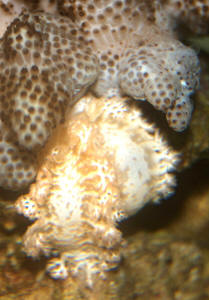
|
|
unknown worms 7/2/10
Hello,
<Hi there>
I have been trying to find out what these worms are crawling on
my glass.
I have a saltwater tank and currently there are no fish in it. I
have tried to get some pictures of these little guys. They are
only a few millimeters long individually but travel in groups
that make them look like branching algae. I apologize for the
picture quality as my camera did not want to focus on the glass
but what was behind it. Any help identifying these little guys
will be very much appreciated.
Thank you for your time,
<Mmm, maybe some species of Nematode... Not likely to be
problematical... with time, succession, addition of livestock,
they will "go". Bob Fenner>
Brian Curler
|
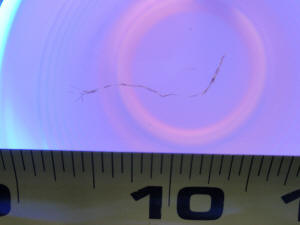 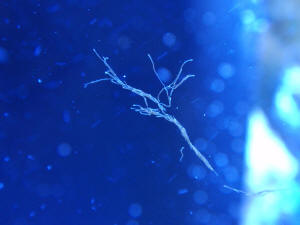 |
|
Worm ID? 5/20/10
Hi, Great site you have, very informative!
I am in the process of setting up a 12 gallon Nano tank. I have
been using a red light at night to find cool hitchhikers on my
new live rock. I saw this worm last night and was able to snap
this picture before he retreated back into the rock. It only
comes out in the dark, approximately a little over an inch long
and gray in color. What type of worm is it? Is it
safe?...thanks!
<Can't tell from your image, even enhanced, enlarged... is
this animal segmented? Does it have any visible lateral
processes? Apparent labial or cephalic structures? Bob
Fenner>
Worm ID?, Sipunculid 5/20/10
Hi, Great site you have, very informative!
<Thanks.>
I am in the process of setting up a 12 gallon Nano tank. I have
been using a red light at night to find cool hitchhikers on my
new live rock. I saw this worm last night and was able to snap
this picture before he retreated back into the rock. It only
comes out in the dark, approximately a little over an inch long
and gray in color. What type of worm is it? Is it
safe?...thanks!
<Looks like a Sipunculid, aka a Peanut worm, harmless to
beneficial.
http://www.wetwebmedia.com/pnutwrmidfaqs.htm
>
<Chris>
Re: Worm ID?
Thank you so much for your quick response!
<Welcome>
<Chris>
|
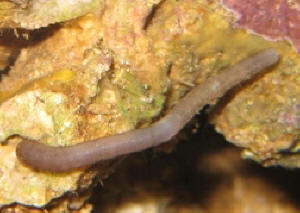 |
|
Mysterious worms 8/19/10
Hi WWM Crew!
<Howdy Lea>
First, I want to thank you all for the voluminous amounts of
information on your site; it's truly a gift to the new
hobbyist and has already saved me hours of worrying.
<Ah good>
Now on to the mysterious worms (aren't they all?).
<Some (for me) much more than others>
I'm pretty sure that one is a spaghetti worm or a hair worm
(I've only seen a couple of tentacles out
at once so far). The only reason I am in doubt is that this guy
appears to have built a tube of his own out of the live sand I
have. If you've heard of tube-building spaghetti or hair
worms that'd be that and Ill let the critter be as I know
they're beneficial.
<Is a type of tubiculous Polychaete, but not a Spaghetti worm
family member... these live in the substrate...>
The other worm I've found is a complete mystery, and
unfortunately the picture is the worse of the two. I just noticed
him today as I was staring at the other worm. He's free
swimming, about a half inch in length and 2-3mm wide,
grayish/mottled, with nubs (don't appear to be distinct
bristles) over his entire body,
<Mmmm, over the whole body? Mysterious indeed, and will need
better resolved pix to identify>
and appears to have some sort of appendages on his head that look
like lobes. He moves about by waving his head around and
attaching it to something. The reason I'm worried is that the
only thing I really have to go on with this guy is how he moves,
and it sounds like a leech… and if it is, I believe
I should remove him (my green clown goby likes to hide under the
ledges of live rock before ambushing some prey
and I'm afraid he'd fall prey to a leech).
Any idea what he is?
<Not a leech>
I've outlined the critter in the attached picture.
Thanks for all of your help � past, present
and future!
~~~><((((º>~~~><((((º>~~~><((((º>~~~><((((º>~~~><((((º>~~~
Lea
<Please send along better image/s when you can. In the
meanwhile, enjoy your system, the life in it. Bob Fenner>
|
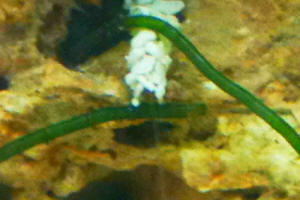 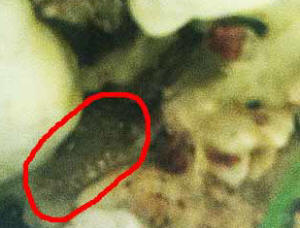 |
|
Worm ID: Likely Synaptid Sea Cucumber --
8/17/10
<Hello Jen, Lynn here today.>
Good day to you!
<Thank you, and you as well!>
I have an interesting worm that I can't seem to find an ID
on.
<I see it and guess what? It's actually a variety of Sea
Cucumber/Holothuroid, mostly likely in the family Synaptidae.
These Cukes are mostly nocturnal, 'moppers'/deposit
feeders that consume organic detritus or sponge secretions. They
do best in large, mature systems but can be offered sinking
pellets as a supplement to their diet. Rob Toonen recommends
dropping a sinking shrimp pellet near the Cuke just before the
lights go out, as this will give the pellet time to soften before
the Cuke begins to actively feed. Regarding size, some Synaptids
can get quite large (5-6 feet/1.5-1.8 meters), however, most seen
in aquaria remain comparatively small. Overall, they're
peaceful but can fall victim to roving hermits.>
I've checked your site and just about every way I can think
of naming it through Google as well. Perhaps you can help?
<Yep, I haven't seen one of these neat little fellows in
quite a while, so I'm more than happy to help!>
These worms were found in the live sand from a tank we recently
purchased.
<Nice>
When we transported everything to our house, I noticed that these
guys were resting on top of the sand in the buckets and figured
they were dead. We got
everything set up and once done, these guys came back to life.
They started to burrow in the sand and by the next day they had
their mouths sticking out with almost tentacle-like
appendages.
<Yep, what you're seeing are the feeding
tentacles/appendages. Synaptid Cukes tend to feed either from a
stationary position, reaching out from within a rock crevice or
sediment burrow, or while actively moving around. Either way,
they can move surprisingly fast when it comes to retracting back
into their burrow/crevice or making a quick getaway.>
I've attached a few pics as well as a link to a video of what
these guys look like. The close up photo isn't very well
done.
<No worries, the combination of photos/video you supplied is
enough to be able to offer that what you have is definitely a
Cuke, and most likely a Synaptid. Besides, trust me, I've
seen photos so blurry/small, that you could hardly distinguish
the rocks from the subject at hand! What you sent is just
fine.>
The big red arrow is pointing towards his mouth (lighter circle
with two black appendages coming out. And the smaller arrows
point to the tentacles surrounding its mouth.
<Thanks>
They seem like they just filter feed,
<Although there are filter-feeding Cukes, Synaptids are
actually deposit feeders, grabbing bits of food from surrounding
surfaces. The most obvious difference between the two involves
the feeding tentacles (since many times that's all you can
see). In lieu of a ring of relatively simple tentacles (like your
individual has), those of filter-feeders generally appear
elaborately branched, feathery, and delicate. The tentacles bring
bits of captured food to the mouth by curling in on themselves,
one at a time, then unfurling back into the water.>
..but their appearance almost makes me wonder if their tentacles
resting on the sand bed and outreached
<Typical position>
..like they are at night could possibly be some sort of predatory
worm?
<Nah, what you have is fairly harmless, even though it's a
Cuke. Normally, when a hobbyist finds out they have a resident
Sea Cucumber, the first thing that goes through their mind is the
dreaded 'Cuke-nuke'. That's when a stressed or dying
individual spews its innards and releases a toxin that can wipe
out a system. Sea Apples are beautiful, but notorious for this.
What you have on your side is the fact that Synaptids lack the
potentially devastating Cuvierian tubules that other Cukes
possess. That's not to say though that what you have is
completely harmless. These Cukes likely have their own defense
system that makes them taste bad (or otherwise discourages
predation), and if you have quite a few, and they all die, you
could have an issue with ammonia. One thing you might want to do
(for right now, anyway) is to run some carbon just in case,
mainly because there may be some die-off (and ammonia build-up)
as a result of the move. Be sure to keep an eye on your water
parameters and be ready to perform some water changes if/when
necessary.>
Any insight on these guys would be greatly appreciated!
<For more information, please see the following links:
http://www.wetwebmedia.com/seacukes.htm
http://www.advancedaquarist.com/issues/nov2002/invert.htm
>
Thanks!
<You're very welcome!>
Jen
YouTube Video: http://www.youtube.com/watch?v=sf7S6p1PcBM
<Take care, Lynn Z>
|
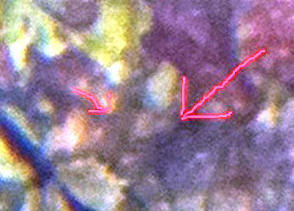 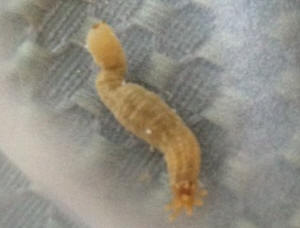 |
|
Marine worm id and recommendations?
5/10/10
Folks,
I've spent many an enjoyable hour reading this site over the
years, both for the reef and freshwater information. Thanks to
Bob and crew for the effort!
<Welcome Ray>
This reef is a 180 gallon, established about three years ago with
150 pounds of Tonga and a stray piece of Florida live rock. It
houses an array of clams, SPS, a few LPS, and a wide variety of
Zoanthids, Anemone, and the like. Fish occupants are a Red Sea
Purple Tang, a Tomini Tang, a Majestic Foxface, a Citron Goby, a
Black Blenny, a pair of Ocellaris Clowns, and two adult Engineer
Gobies. A handful of hermit crabs and cleaner shrimp complement
the crowd. I was feeding my Trachyphyllia today when I noticed
this 'little' individual tentatively poking his nose out
and pulling back in between the folds.
<A big ole Polychaete worm>
He eventually threw a loop around the half silverside, bit into
it, and jerked it out of the coral and underneath to his hiding
spot. I'm leaning toward this being a Eunice, and debating
whether I want to try and bait it out for removal, or whether I
should rely on my Engineer Gobies to stumble upon it for a snack
(they've sported bristle-moustaches
in the past). Thoughts?
<Is a bit too large I suspect for the Pholodichthys... I would
likely try to remove it/this by trapping... possibly
tongs!>
Thanks,
Ray
<Welcome. BobF>
|
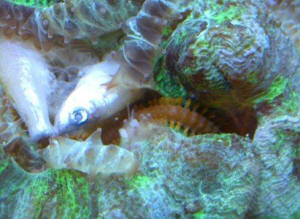 |
Thread like worm ID 3/27/10
I have a 90 gallon reef tank. I recently switched from a crushed coral
bottom to sand. Since I switched to the sand I now have these thin as a
hair type of worms all through my sand. They seem to be sticky because
the only reason I can see them is because the sand sticks to them. If I
pick up a rock in my tank you can see them also just hanging from the
bottom of my rocks like long hairs. The problem is these little suckers
sting! I had touched them and OUCH, they stung me! Also, my spotted
garden eel
<These species are NOT easily kept. See WWM re>
won't go into the sand because of them. I don't know what they
are or how to get rid of them. Please help.
Melissa.
<Help with? Likely these are some species of Errantiate Polychaete
worm... And very likely they will "go" of their own accord as
your system "ages". I would do nothing specifically to rid
your tank of them. Do read here:
http://wetwebmedia.com/polychaetes.htm
and the linked files above. Bob Fenner>
|
Trying to identify if the attached pictures are
worms/tunicates/or something else 3/12/10
Hello Crew,
<Hello Chip>
I hope you can help me identify my fisherman.
<I'm going to try!>
Well aged tank and live rock. I've had these guys in my tank
since before I upgraded from a 30 to a 75.
<Ok>
They form what feel like calcareous tubes which protrude from the
live rock. During feeding I see long mucous like
strands coming from them catching bits and pieces and appear to
slowly real them in.
<This is a BIG clue>
They sprout like crazy and hopefully won't hinder the
movement of the anemones too much.
<Doubtful, but why do you want your anemones to move? This is
the worst thing they can do>
I have attached two pics (best I could do with focus).
<I see these.. not possible to identify from these
alone..>
Any hints would be helpful.
<Ok, I'll give you one here... WORMS! Yes, I do believe
that is what you have here, a beneficial life form indeed, enjoy
the biodiversity and have a read on some of these:
http://www.wetwebmedia.com/polychaetes.htm
http://www.reefkeeping.com/issues/2002-06/rs/index.php
http://www.chucksaddiction.com/hitchworms.html>
Thanks,
<No worries>
Chip (Arlington, Va)
<Simon (Truro, Cornwall at the moment)><<Perhaps w/
coralline algae growing on the outside of the tubes.
RMF>>
|
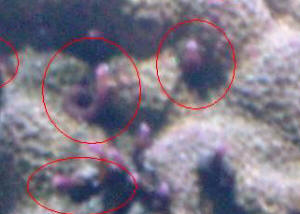 |
Re: Trying to identify if the
attached pictures are worms/tunicates/or something else.
3/12/10
<Hello Chip>
You may not have expected an answer, but here's one.
<Ok...>
I appreciate the fact that you are trying to help people with their
problems and questions...but don't make them look like a jerk
in the process.
<I did not mean to Chip, at all. I have no idea of your level of
expertise>
See below. I know an anemone shouldn't move if it is healthy
and in a good environment...perhaps you should have explained why
it isn't good for an anemone to move or explain why it would
move here.
<There is plenty to be read on the subject:
http://www.wetwebmedia.com/marine/inverts/cnidaria/anthozoa/anemones.htm>
Just an etiquette FYI.
<Thank you for this, Simon><<"Chip" on his
shoulder? B>> |
Worm ID 3/11/09
Hi,
< Hello >
I have read and read the posts from your site, and have not come across
anything that has helped me identify a worm in my tank. At first, I
thought maybe they were 'baby' bristle worms, but I have
decided they are not. My sand is FULL of tiny orange or red worms that
sometimes come out and attach themselves to the walls of the tank...but
mostly stay hidden in the sand.
They are usually 1/4 to 1/2 inch in length, very thin, and seem to have
tentacles on one end. At first I thought it was just some sort of plant
growth/algae that would appear on the back glass, but upon close
inspection,
you can see it moving around. So it MUST be some sort of worm like
creature.
When I do water changes, and siphon up detritus from the sand... the
sand is FULL of these creatures. I have yet to come across any pictures
of this creature, and it is so small, I don't know if I can get a
good picture of it.
I will try... Also, when I disturb the sand (siphoning for water
changes) they ball up, and float back down with the sand.. it is very
hard to remove them. I have a 130 gallon tank, and there are (seems
like) millions of these things. They only showed up after the tank was
established for a year.
< Sounds like Spaghetti worms. Harmless detritivores. There is a pic
of one at the bottom of this link..
http://www.wetwebmedia.com/polychaetes.htm
Here are a couple of links if your are interested in learning more
about these guys.
http://www.reefkeeping.com/issues/2002-06/rs/index.php
http://www.waquarium.org/_library/images/education/marinelifeprofiles/spaghettiworm0909.pdf
GA Jenkins >
Re: Worm ID 3/13/10
I looked at pics and read all the info.. DEFINITELY NOT spaghetti
worms.
They are reddish in color
< Spaghetti worms can be found in many colors including red.>
and when I vacuum detritus from bottom, there will be hundreds floating
around that come from in the sand. Some will eventually stick to the
sides of the tank. I have not seen any that are more than maybe a half
an inch long.
< There are numerous worms and critters that make their homes in our
tanks sandbeds and rock work. Most are detritivores and harmless.
I'm still thinking Spaghetti worms but either way I wouldn't be
to concerned. GA Jenkins >
|
Blue worm, "You put the moon in my eyes..."
3/9/10
Can you tell me what this is?
<Oh yeah... Please see here:
http://wetwebmedia.com/polychaetes.htm
Looks like a common Hermodice sp.>
He is 12 inches long
<Yikes!>
and I can't find
one like him on line. His blue strip is very blue. Will he kill
my fish or my bottom living things, i.e., crabs, star fish,
snails etc?
<Might, yes>
I have looked everywhere on line and can't find another one
that is red and blue. Thank you.
Marti Liska
<Welcome! Bob Fenner>
Blue and red bristle worm 3/9/10
Hi:
<Yes Marti; same resp. as last>
I just bought a home with an established 14 year old 150 gallon
salt water aquarium in it. I am learning fast. However, a few
days ago I saw a ~10 inch long worm. I have established that it
is a bristle worm from my reading however, I have yet to see a
picture of one like this one. It is red on the outer edges and
has a sky blue strip down the center of the worm.
Now, I purchased 4 little gobies and they died. Next, my clown
fish was obviously getting sicker by the hour and died. Then
another fish that had been in the aquarium for years died. The
worm somehow got the dead fish in its "cavern" and
pulled it under the rock and I believe ate it. I called my
"fish man" who takes care of my system and he came
right over and said that my nitrates were "off the
chart." He did a 40 gallon water change and is going to do
one every other day until we are all systems go again so I can
get my new fish I have ordered from him. My two very large tangs
are fine, so are my star fish and other things like snails and
crabs (although I found one dead and out of his shell). I
don't know what to think about that.
After the first water change all the fish started doing much
better. But, this worm!!!! What on earth is this thing? Why have
I never seen another one on line with a sky blue strip down the
center? And most importantly, will he hurt my fish? He lives in
the same cavern in the rock that my big blue tang and
"his" cleaner shrimp live in and they don't seem to
be bothered by him. He does spend a lot of his time under the
rock but with a flash light I can see him in the back of the
cavern at times and once he was out late at night. Why can't
I find one on line with a blue strip and red edges? I do have
pictures of him but they are not down loaded yet.
Please let me know if he will kill any of my fish or other living
things. He is so
scary looking. I will email you a picture from my IPhone if that
will help.
Thank you in advance,
Marti Liska
<Welcome! BobF>
|
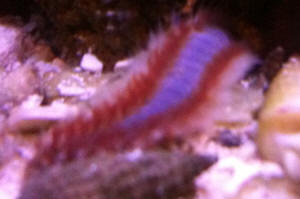 |
Blue worm, "You put the moon in
my eyes..." he might eat them? oh no! 3/9/10
OK, so should I ask my fish tank person (I live in Ann Arbor during
the week and on Lake Michigan on the weekends, that is where my
fish are) to try to get rid of him?
<Mmm, up to you... not likely to change its behavior
overnight... Whatever food/circumstances have precluded it munching
on your macro-stock to date...>
Will he know how to do that given how big he is.
<... please read where you were initially referred to. There are
FAQs files on control...>
He might be 14 years old as the rock has been there that long. He
only ate the dead fish so far. Matt, my caretaker during the week
said he was okay, but now I don't know. He got my first fish
for me and all 4 of them died, however, he designed the tank 14
years ago and has been taking care of it and the sub-tank in the
basement since then.
<Neat!>
All the fish that came with the tank are alive except my clown fish
(I loved the little guy) Do I trust him (Matt)?
<Obviously so>
I get so attached to those little guys, I just can see them die!!!
Two of my tangs are huge (several years old) and beautiful and so
are my starfish (the worm spent two days laying right next to the
starfish and didn't eat him). If he hasn't eaten them so
far should I assume I am safe and that he will just eat the
occasional crab or snail?
<Likely so>
Have you ever seen one with a bright blue stripe like in the pic I
sent?
<Yes... see my bio., posted on WWM, in books I've penned...
I've spent a few years "sorting and identifying"
Errantiates>
Where can I go to read about these blue stripped worms.
<Again...>
I am an attorney and therefore a reader by trade.
<Maybe have your assistant, paralegal read for you?>
I like to do things right and simply can't see my investment go
down the tank. The aquarium is part of a wall in my library in my
beach home and is so beautiful framed in imported cherry.
<Nice!>
It is so beautiful and I have ordered several hundred dollars worth
of fish and other things. I ordered two feather dusters that he
will get for me (he goes to Lansing, Michigan and gets the fish
himself). What if he eats them!!!!
<... so?>
These guys are my little friends and I simply can't take
"he might eat them." Please tell me where to read about
these blue and red stripped worms. Help me! My little weekend
friends are in danger.
Thank you ever so much for you kind attention to my requests. I am
new to this and I really love it.
Marti Liska
<Thank you for sharing Marti. BobF> |
Green Caterpillar-Looking Worm --
2/23/10
Hi there,
<Hello there, Lynn here today.>
I am a beginner aquarist and have a small saltwater tank.
<Yay, welcome to the hobby!>
I have sighted a green caterpillar-looking worm on my live rock.
<Neat>
I have spent hours looking for a similar worm (if that's what it
is).
<It works (for me anyway) as a broad term for any soft bodied,
elongate critter with a head at one end, that either has no legs at
all, or many on either side (like a centipede or caterpillar). In
saltwater, there are many, many worm-like organisms -- from the
bizarrely shaped to the seemingly very simple.>
I've only seen it twice, but since I am such a novice, I need to
know if it is harmful or just let it be.
<I'd leave it. Most of these small hitchhiking 'worms'
are beneficial or at least fairly innocuous in reef systems.>
My water tests have been close to perfect for 2 months.
<Sounds good. Just remember to be specific with these numbers (as
well as tank size and current livestock) if/when you need to write us
with any questions related to water quality, disease, and so forth. For
an ID query like this, we're good to go!>
Have you ever seen something like this?
<Well, I've seen bright green worms before, but without a photo,
I'm not sure if they looked like yours! If the individual you have
is long and skinny, with many bristly legs, it could easily be a
Phyllodocid (a common Polychaete in the family: Phyllodocidae). If
there are no apparent legs, it could be a Nemertean (Phylum: Nemertea).
Both prey mostly on small invertebrates but should have negligible
impact on a healthy population. Beyond the two possibilities already
mentioned are a host of others. Again, I'd leave this little fellow
in place and enjoy. For more information regarding Phyllodocids,
Nemerteans, and other worm-like critters, please see the following
links:
http://www.chucksaddiction.com/hitchworms.html
Be sure to check out the related/highlighted links at the top of the
following pages as well:
http://www.wetwebmedia.com/worms.htm
http://www.wetwebmedia.com/polychaetes.htm
It is approximately 1 1-1/4 inches.
<Gotcha, thanks>
Thank you very much for your help!
<You're very welcome and thank you writing us. I hope that your
first experience here has been a positive one for you. Take care,
LynnZ>
Re: Green Caterpillar-Looking Worm -- 2/23/10
Dear Lynn,
<Hey Victoria and Kyle!>
I really appreciate your speedy response.
<It's a pleasure. I know all too well what it's like to find
something odd in a tank and wonder what it is!>
I will try to take a photo of the critter the next time he is out in
the open.
<Excellent>
He does not have any legs and looks EXACTLY like a green caterpillar
with little thorn looking things all over.
<Hmmm, thorny sounds more like a Sea Cucumber, but it could also be
some sort of Nudibranch or Sea Slug. Please see the following links for
comparison:
Sea Cucumbers: http://www.wetwebmedia.com/seacukes.htm
Nudibranchs - 6 pages, starting here:
http://www.wetwebmedia.com/nudibran.htm
Sea Slugs: http://www.wetwebmedia.com/seaslugsopisthobranchs.htm
>
I will hope that he is a helpful janitor and not a menace.
<Me too. We'll know more once we figure out what it is. By the
way, if you've added any corals at all, let me know what variety.
Also, if you know where this animal hitchhiked in from, that would be
terrific.>
I have had 2 peculiar snail deaths (orange shelled guys).
<I'm not sure what variety this is. Do you have any other
snails? If so, how are they doing?>
I will definitely be coming to your website a lot in the future!
<Great!>
Very well done and informative!
<On behalf of Bob and the crew, thank you very much!>
Thank you VERY much!
<You're most welcome!>
Victoria and my 8 year old son, Kyle
<Y'all take care, LynnZ>
|
Worm ID Needed 02/02/10
Last night I was walking by my tank, saltwater. I noticed this
tiny orange colored worm on the glass. I have attached a photo
showing it. The worm is only about 1/2" long. It was on the
glass long enough to get a photo,
and then it kind of curled up and floated back to the substrate.
Any ideas?
<The photo is not clear... but, from what you describe, this
looks/sounds like an epitoke (a swimming reproductive stage) of
an Eurythoe sp. bristle worm.
Here's a nice site for worm IDs
http://www.chucksaddiction.com/hitchworms.html>
Cary Meredith
<Cheers,
Sara M.>
|
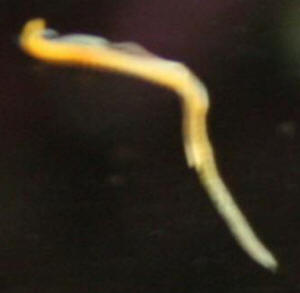 That babe is on! RMF That babe is on! RMF |
|
Worm ID: That's No Worm, That's Trouble with A
Capital T: Tritoniid Nudibranch - 1/26/10
Hi Crew, Hi Mr. Fenner,
<Hello Claire, Lynn here this evening.>
I hope you all are feeling well.
<Thanks, just like the old song, I'm feelin'
alright!>
I have a problem.
<I'm sorry to say that judging from the photos, you do
indeed.>
A few days ago, during the night, I paid attention to a worm
(looking like a slug) on the glass of the aquarium. I took a
picture, but I did not send it, as I got only the ventral
face.
Yesterday night, I remarked that two curious "critters"
were on the rock of my Cladiella (closed for the night).
<Never a good sign, but helpful for ID purposes.>
I succeed to take an "acceptable" shot today and my
questions are:
1)What kind of worm is it (I did not succeed to identify it
myself from the WetWebMedia site)?
<Unfortunately, it's not a worm. It's a predatory
Nudibranch, most likely Tritoniopsis elegans (family
Tritoniidae). These little guys are very pretty but unfortunately
eat soft corals like your little Cladiella. Have you noticed any
damage to this, or any other softies?>
2) Is it a pest,
<When it comes to soft corals, yes indeed.>
..and if yes, how to eradicate it (I never saw it in the tank
before,
<Hopefully they'll be out and about again tonight. If so,
I'd opt for physical removal. You might want to try
suctioning them out with a turkey baster. Be sure to have a net
handy though, just in case one gets away. Please see the
following link for more information (be sure to go through all
associated links at the bottom of the page as well):
http://www.seaslugforum.net/factsheet/triteleg
Google Tritoniopsis for the many WWM FAQ's re:
http://www.wetwebmedia.com/Googlesearch.htm >
..but I suppose that there are a lot of creatures I never
remarked too) ?
<Yep, there's a whole other crew that emerges when the
lights go out!>
Thank you for your wonderful help and patience,
<You're very welcome and good hunting!>
Kind regards,
Claire
<Take care, LynnZ>
|
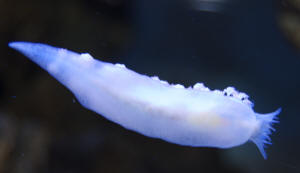  |
|
Help with Worm ID: Likely Terebellid --
1/26/10
Hello Crew,
<Hello Ariel, Lynn here today.>
I've been a big fan of your website for many years. This is
actually my first question since I usually find the answers
here.
<Let's get to it then!>
I have a small ten gallon that I use for quarantine. It has some
live rock and sand. I'm recently using it since I bought some
corals but I had the lights off for about a month or more since I
had broken the bulb. I noticed two days ago that I have a certain
tube worm creature under one of the rocks and would like to know
if it's bad.
<Probably not. The overwhelming majority of worm/worm-like
hitchhikers we see are actually harmless/beneficial. The rest are
mostly innocuous with only the occasional troublemaker.>
The tube is about an inch high kind of built out of sand grains
it looks like. Then it has some tentacles sticking out of the
top. Maybe 5 or 6 of them. They kind of search around the rocks
like looking for prey.
<Bits of detritus.>
They get pretty long. One in particular was about 6 to 8 inches
long reaching around the next rock. Thinking maybe like a
Terebellid worm or Spionid worm?
<I think you hit the nail on the head! It sounds like a
Terebellid (aka spaghetti worm). They're harmless,
tube-dwelling, detritivores that extend numerous thin tentacles
over surfaces in search of food particles. Spionids are neat
little Polychaetes as well, but have two small feeding
palps/tentacles instead of many.>
Thanks in advance
<You're very welcome.>
Ariel
<Take care, LynnZ>
|
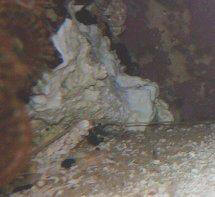 |
|
|

